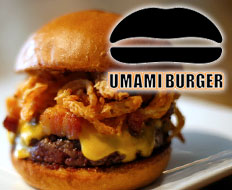Umami Burger is a highly successful chain of burger joints founded in 2009 by Adam Fleischman. Having read about umami (the “fifth taste”) in food blogs and books—and as a fan of In-N-Out Burger—Fleischman thought he could successfully apply its principles to the classic American burger. He was right; the restaurant became a runaway success, and two years later, Fleischman’s product and brand were so well recognized that he partnered with hospitality group SBE, Nimes Capital, and Fortress Investment Group to take Umami national.
Most people think the difficult part of being a restaurateur is creating a successful concept, but the real challenge lies in sustaining and growing a restaurant once it has gotten some traction. Today, Umami Burger has 18 locations, most in California, with one each in Miami and New York City. My instincts tell me it could easily continue to grow regionally by increasing same-store sales and strategically introducing new stores. For example, look at In-N-Out Burger: All of its 281 stores are a day’s drive from a regional distribution center. It serves a world-renowned product that is only available in five states, all of them west of the Mississippi.
CLOSER LOOK
UMAMI BURGER
LOCATIONS: 20
WHERE: California, Florida, New York
WHAT: Burgers
ESTABLISHED: 2009
OWNER: Adam Fleischman, SBE Entertainment
But Umami Burger has chosen a different course. Fleischman and his partners have opened two stores 3,000 miles away from the company’s home. The New York and Miami markets offer tremendous opportunity for expansion and have dense populations of the affluent customers who frequent Umami Burger. The problem is, the stores are very far from the organization’s home base and are highly competitive with strong local players. This is not to say Umami Burger will not have success in these markets—there was a three-hour wait during its New York debut—but the question is, can it hold up against Shake Shack, Burger Joint, J.G. Melon, PJ Clarke’s, and many others?
Time will answer that question. But for others hoping to take their brand to the next level, I’ve come up with four components to maximize the chance for success.
No. 1: Talent. The first and probably most important part of the expansion equation is to hire quality people. When you are expanding, hiring the right talent is everything. As James Collins says in his book Good to Great: “Consider the idea that charisma can be as much a liability as an asset. Your strength of personality can sow the seeds of problems.” A charismatic founder can be very involved in what is happening when the business is local, but when it expands over large distances, it is the people you hire who will be left to make the decisions. No matter what infrastructure you have built, the right people are the ones who make the right decisions for your business.
No. 2: Simplicity. When Thomas Keller opened Per Se in New York, he installed cameras in its kitchen and in the kitchen at French Laundry, his California restaurant, so he could accurately monitor what was happening in real time at both locations. This approach, though admirable, is not a strategy for large-scale expansion. Simplicity equals consistency. The more complex your product, the less likely it can be duplicated. Moral of the story: Keeping it simple keeps the odds of success in your favor.
No. 3: Measured pace. How many things can you do well at once? Very few people can successfully multitask, and you are likely not one of them. When expanding your business, you must move at a measured pace. If history has taught us anything, it is that no one can win a war fighting on too many fronts. The supply lines eventually get cut off, bad weather sets in, and things start falling apart. Whatever can go wrong will go wrong. Slow and steady always wins.
No. 4: Location. The majority of dining decisions are made based on location. You may try a destination spot once or twice for a special occasion, but if you are hungry, odds are you are going somewhere close. Choosing high-traffic locations in great neighborhoods will help your business tremendously. Remember, if you are spending time looking for customers, you will have a lot less time to spend impressing them.
As you ponder the decision to expand your business, you will inevitably come to what I call “the expansion dilemma,” and one of my favorite stories sums this dilemma up perfectly. There was once a big executive who went on vacation to an island. He was on the beach and saw a small shack where the local fisherman and his family were eating lunch. The fisherman invited the executive to join them. When the executive tried the fish, he was amazed. It was the best fish he had ever eaten. He told the fisherman that he should sell the fish. The fisherman asked how to do that, and the executive explained that first he should get a bunch of boats and start selling to the other islands, and then, after a while, build a factory and start shipping all over the world. “And then what?” the fisherman asked. The executive said, “Then you can sell your business and do whatever you want all day.” And the fisherman replied, “I already do that.” Bottom line? Everyone has his or her own taste for life.








